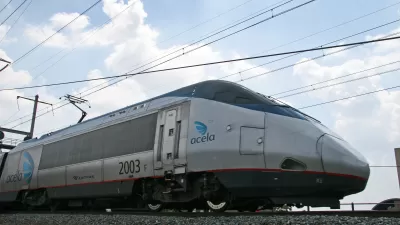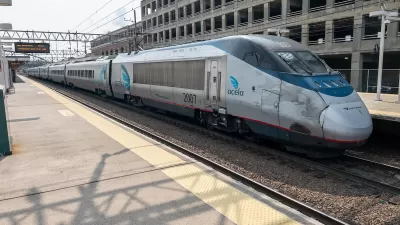Long lines at airport security and weather delays have contributed to Amtrak's commanding travel mode share between D.C. and NYC, and majority share between NYC and Boston, but the lead is threatened by the competition and aging infrastructure.
Ron Nixon describes how Amtrak travel in the Northeast, the nation's busiest corridor, took off after the introduction of Amtrak's high-speed Acela train in 2000. Prior to its introduction, the nation's train service had 37% of the travel between NY and D.C. and 20% between NY and Boston.
The mode share has jumped to 75% and 54% respectively, greatly boosted by the tightening of airport security after Sept. 11, 2001m which added long waits and inconvenience to air travel. Another highly valued amenity is the on-board wi-fi and ability to use cell phones.
"But success is taking a toll. Most days, trains in the Northeast are full. Several locomotives and railcars are 30 years old or more. Aging rails, bridges and tunnels hold down top speeds and limit expansion of the network.
Last month, Amtrak unveiled an ambitious $151 billion proposal to speed up trains and upgrade bridges and tracks."
Federal funding is lacking and competition is increasing.
"Amtrak faces a $6 billion backlog in maintenance projects nationwide. The transportation bill passed last month did not include money for rail projects. Transportation advocates like Jim Repass, president of the National Corridors Initiative, said this left Amtrak's budget subject to annual appropriation bills in Congress."
Amtrak's most formidable competition may not be the Delta Airlines and US Airways shuttle services that are facilitating the security check-in for their loyal customers but lower priced alternatives.
"BoltBus and MegaBus, two downtown, curbside services in the Northeast, have increased ridership since they began operating in 2008. The buses generally make the New York-to-Washington run in four and a half hours and offer free Wi-Fi. Tickets range from $1 to $40, far less than Amtrak or the airlines.
Research suggests that they are eating into Amtrak's market share. According to a study by the Chaddick Institute for Metropolitan Development at DePaul University, 34 percent of bus riders said they would have taken Amtrak if not for the bus."
FULL STORY: Frustrations of Air Travel Push Passengers to Amtrak

Maui's Vacation Rental Debate Turns Ugly
Verbal attacks, misinformation campaigns and fistfights plague a high-stakes debate to convert thousands of vacation rentals into long-term housing.

Planetizen Federal Action Tracker
A weekly monitor of how Trump’s orders and actions are impacting planners and planning in America.

In Urban Planning, AI Prompting Could be the New Design Thinking
Creativity has long been key to great urban design. What if we see AI as our new creative partner?

King County Supportive Housing Program Offers Hope for Unhoused Residents
The county is taking a ‘Housing First’ approach that prioritizes getting people into housing, then offering wraparound supportive services.

Researchers Use AI to Get Clearer Picture of US Housing
Analysts are using artificial intelligence to supercharge their research by allowing them to comb through data faster. Though these AI tools can be error prone, they save time and housing researchers are optimistic about the future.

Making Shared Micromobility More Inclusive
Cities and shared mobility system operators can do more to include people with disabilities in planning and operations, per a new report.
Urban Design for Planners 1: Software Tools
This six-course series explores essential urban design concepts using open source software and equips planners with the tools they need to participate fully in the urban design process.
Planning for Universal Design
Learn the tools for implementing Universal Design in planning regulations.
planning NEXT
Appalachian Highlands Housing Partners
Mpact (founded as Rail~Volution)
City of Camden Redevelopment Agency
City of Astoria
City of Portland
City of Laramie




























